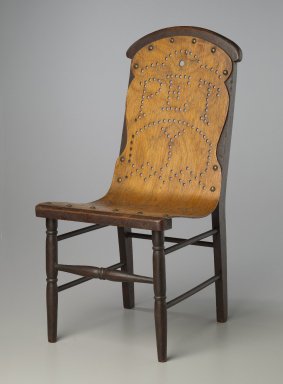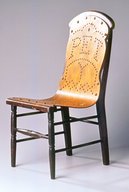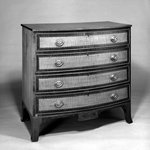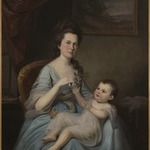Child's Chair
Decorative Arts and Design
On View: American Art Galleries, 5th Floor, Several Seats
Gardner was a family-run furniture company that secured several United States patents for its innovated seating furniture. The patent on this chair was for the one-piece plywood seat and back, an early use of this progressive material that would reach its greatest utility in the mid-twentieth century. Patents were of two types: technical patents, like the one here, and design patents. Manufacturers used patents to promote their wares as progressive and novel. Gardner exhibited similar chairs at the Centennial exhibition and garnered awards for their ingenuity.
MEDIUM
Wood, plywood, brass
DATES
Patented May 21, 1872
DIMENSIONS
18 1/8 × 8 5/8 × 10 in. (46 × 21.9 × 25.4 cm)
mount: 18 × 8 3/4 × 11 in. (45.7 × 22.2 × 27.9 cm)
(show scale)
MARKINGS
Impressed on back, left of "Y" piercing in rectangle: "GARDNER'S / PATENT / MAY 21 1872"
ACCESSION NUMBER
1998.88
CREDIT LINE
Maria L. Emmons Fund
PROVENANCE
Prior to 1998, provenance not yet documented; by 1998, acquired by The Fireplace Antique Shop; 1998, purchased from The Fireplace Antique Shop by the Brooklyn Museum.
Provenance FAQ
CATALOGUE DESCRIPTION
Doll's or Child's Side Chair: wood, plywood, brass tacks. Two turned front legs with rings in center and near juncture with seat rail are joined by a turned, double-ringed stretcher above midpoint and by a plain front seat rail. Two plain stretchers on each side and one plain stretcher connecting rear legs. Rear stiles form rear legs then cant backward to support back; connected at top by arched crest rail. Back and seat formed by continuous piece of three-ply plywood with shaped edges at back, connected to frame by six brass tacks at front seat rail, six brass tacks at crest rail and two brass tacks at each rear stile near where rear seat rail would be. Seat pierced with star in circle in rectangle; back pierced with the word "PET' below pierced crest and above "Y" under arc.
Condition: Some joints loose. Plywood splintered at mid-section of proper right edge of seat. Stain on finish of seat. Some splintering around pierced holes on underside, especially at seat and near central hole near crest. Oxidation to brass tacks. General wear.
CAPTION
Gardner & Company (1863–1888). Child's Chair, Patented May 21, 1872. Wood, plywood, brass, 18 1/8 × 8 5/8 × 10 in. (46 × 21.9 × 25.4 cm). Brooklyn Museum, Maria L. Emmons Fund, 1998.88. Creative Commons-BY (Photo: Brooklyn Museum, CUR.1998.88.jpg)
IMAGE
overall,
CUR.1998.88.jpg. Brooklyn Museum photograph, 2010
"CUR" at the beginning of an image file name means that the image was created by a curatorial staff member. These study images may be digital point-and-shoot photographs, when we don\'t yet have high-quality studio photography, or they may be scans of older negatives, slides, or photographic prints, providing historical documentation of the object.
RIGHTS STATEMENT
Creative Commons-BY
You may download and use Brooklyn Museum images of this three-dimensional work in accordance with a
Creative Commons license. Fair use, as understood under the United States Copyright Act, may also apply.
Please include caption information from this page and credit the Brooklyn Museum. If you need a high resolution file, please fill out our online
application form (charges apply).
For further information about copyright, we recommend resources at the
United States Library of Congress,
Cornell University,
Copyright and Cultural Institutions: Guidelines for U.S. Libraries, Archives, and Museums, and
Copyright Watch.
For more information about the Museum's rights project, including how rights types are assigned, please see our
blog posts on copyright.
If you have any information regarding this work and rights to it, please contact
copyright@brooklynmuseum.org.
RECORD COMPLETENESS
Not every record you will find here is complete. More information is available for some works than for others, and some entries have been updated more recently. Records are frequently reviewed and revised, and
we welcome any additional information you might have.




































